Abercrave is a former mining village which lies in the extreme south of Powys, formerly Breconshire, in the Upper Swansea Valley, just 2 ½ miles from Ystradgynlais. Underground mining of coal ceased in the 1960’s, although an opencast mine still operates in the area. There does not appear to be a war memorial in the village for those who fell in the Great War, but one local newspaper, the Llais Llafur, published a list of 24 names for inclusion on a proposed war memorial for the village, in its issue of 27 September 1919. The names included: James Mallows; Tom Thomas; Willie Jones; Isaac Griffiths; William Hull; Tom Morgan; John James; Leonard Colwell; David Hughes; James Whiting; Oswald Thomas; Rees Howells; John Allen; William Hoskins; John Johnson; William Lewis; George Mountjoy; David Taylor; Thomas John Morgan; Arthur Palmer; Oswald Watkins; William Francis; David John Samuel; and Hopkin Morgan. Friends and relatives were asked to contact the author of the article if there were any errors or omissions.
World War One, 1914-1918
John Allen, Private, 15110, South Wales Borderers. John was born at Rowley Regis in about 1869. He married in 1895 and lived with his wife Alice Allen in Rowley Regis before getting a job as a labourer in a coal mine at Abercrave and moved his wife and their six children down to 14, Brookland Terrace, Abercrave. He enlisted at Ystradgynlais into the South Wales Borderers and was posted to the 1st Battalion, South Wales Borderers, which was in France attached to 3 Brigade, 1st Division. The division had been one of the first to arrive in France, fighting at the Battle of Mons, and taking part in the retreat to the Marne, where the Germans were stopped. They then fought at the Aisne, and at Chivy, before being moved north to Ypres. Here they fought at the First Battle of Ypres, where they again stopped the German Offensive, before wintering in Flanders, in the Festubert sector. The battalion supplied working parties for the first few weeks of 1915, moving to Givenchy on 14 January, where it continued work on trench consolidation. These weeks had been relatively quiet, but the peace was broken when the front line and canal lock at Givenchy came under fire on 24 January. This was a prelude to a larger bombardment which occurred the following day, at 08.00 on 25 January 1915, and saw the entire Givenchy front heavily shelled before the Germans attacked in force and penetrated Givenchy village. Heavy fighting continued for hours, but a combined effort from the 2nd Welsh, Black Watch and 1st South Wales Borderers finally drove the Germans back before mid-day. John was one of many men killed during the day. The 45-year-old has no known grave and is commemorated on panel 14 of the Le Touret Memorial, Richebourg-L’avoue, France.
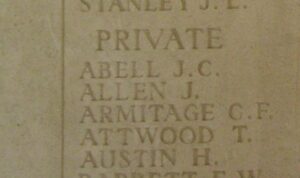
Ambrose Collict, Sapper, 156136, Royal Engineers. Ambrose was the son of John and Amelia Collict, of 75, Maerdy Road, Mardy. He lived at Bryntawe, Brickyard Close, Abercrave with his brother William John Collict prior to the war, where he worked as a Collier. He was an army reservist and returned to Mardy to re-enlist into the 3rd Battalion, Royal Welsh Fusiliers on 31 August 1914 and embarked for France on 28 December 1914, joining the 2nd Battalion, Royal Welsh Fusiliers, which was in Flanders attached to 19 Brigade. The brigade was an independent unit which became attached to the 6th Division on 12 October 1914, and saw action in northern France, before transferring first to the 27th Division and then to the 2nd Division prior to the Battle of Loos. Ambrose was caught asleep at his post on 2 July 1915 and was sentenced to three years penal servitude, but distinguished himself by his gallantry during the Battle of Loos on 25 September 1915 and the sentence was quashed. On 31 May 1916 Ambrose was transferred to the 176th Tunnelling Company, Royal Engineers, which was one of a number of such units being formed from a core of former miners, in order to construct dug-outs and tunnels and to dig mines beneath enemy positions in order to fill with the explosive Ammonal and detonate to create holes in the line. He was gassed on 13 May 1916 and spent some time in hospital before joining the 173rd Tunnelling Company, which was at Ypres in 1917, where an enormous amount of work had been completed, including excavating the 21 mines underneath Messines Ridge. He was wounded by gas again, during the build up to the launching of the Third Battle of Ypres, and died of his wounds at 47 Casualty Clearing Station, Proven on 23 July 1917. He was buried in grave I. I. 11. in Dozinghem Military Cemetery, Belgium. His name does not appear in the original list of proposed names for the Abercrave War Memorial.
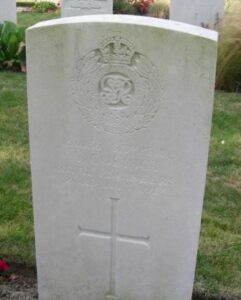
Leonard William Colwell, Corporal, 15313, Machine Gun Corps. Leonard was born in Hatfield, Herefordshire, the illegitimate son of Harriet Colwell. His mother later married George Christopher Passey, of Dhobie Cottage, Hatfield, Leominster. Leonard came to Abercrave to work prior to the war and lived at Troedybryn Terrace with his uncle and aunt before returning to Leominster to enlist into the King’s Shropshire Light Infantry. He was posted to France where he transferred into the 8th Battalion, Machine Gun Corps, which was attached to the 8th Division. The Division had been in France since November 1914, and had fought at the Battle of Neuve Chapelle, and then at the Battle of Aubers. It saw further fighting at the Action of Bois Grenier, before moving to the Somme in 1916 and took part in the great offensive there. In March 1917 the division followed the German Retreat to the Hindenburg Line, and later that year moved to Ypres, fighting at the Battles of Pilckem and Langemarck. In March 1918 the Division was on the southern end of the Somme, and met the German Offensive head on seeing heavy fighting over the coming weeks. Leonard was killed in action on the Somme on 26 April 1918, just before the division was pulled from the line to rest. The 23-year-old is buried in Crouy British Cemetery, Crouy-sur-Somme, France.
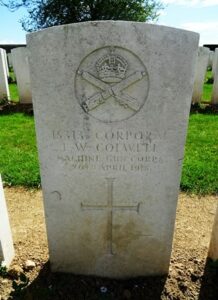
William Francis, Lance Corporal, 28582, Welsh Regiment. William was born in Warminster. He worked as a coal hewer at Abercrave prior to the war and lived at Shop House. William enlisted at Ystalyfera into the 18th Battalion, Welsh Regiment (2nd Glamorgan), which was attached to 119 Brigade, 40th (Bantam) Division. The Division moved to France during the first week of June 1916, and moved to the front near Loos. Late in 1916 it moved south to the Somme, and fought at the Battle of the Ancre, remaining in the Rancourt sector over the winter. During the first days of January 1917 the battalion was holding the line in the Rancourt Sector, and suffered a number of casualties on a daily basis, with several men wounded and a number of men being posted sick due to the terrible conditions, before being relieved on 4 January. William was among the men wounded at this time and was evacuated to the base hospital at Boulogne where he died of his wounds on 13 January 1917, aged 31. He is buried in grave VIII. C. 179. in Boulogne Eastern Cemetery, France.
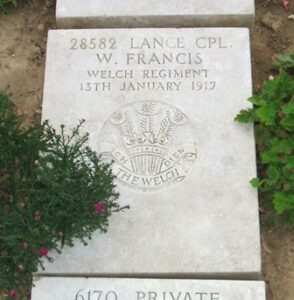
Isaac John Griffiths, Private, 11639, South Wales Borderers. Isaac was the husband of Mary Griffiths, of Troed-y-Rhiw Cottages, Abercrave. He was an army reservist and worked at the International Colliery prior to re-enlisting at Brecon into the 2nd Battalion, South Wales Borderers. The battalion had landed at Plymouth on 4 December 1914 following a successful campaign against the German garrison of Tsingtao in China. It entrained for Rugby to join 87 Brigade, 29th Division and embarked with the division at Avonmouth on 17 March 1915 to sail for Egypt, before landing at Gallipoli on 25 April 1915. The division saw much action during the Gallipoli campaign before being evacuated to Egypt on 11 January 1916 and after a brief rest sailed for Marseilles where it disembarked on 15 March 1916, entraining for the Somme. The Division took part in its first major action in France during its attack on Beaumont Hamel on 1 July 1916, and suffered heavy casualties. It fought in the latter stages of the Somme offensive before moving to the Arras sector and fought at the Battle of the Scarpe in April 1917. It was then moved to Ypres and fought at the Battle of Langemarck, and then at the Battles of the Menin Road, Polygon Wood, Broodseinde and Poelcappelle, before moving to Cambrai. Here the division fought at the Battle of Cambrai in November and December 1917 before moving back to Flanders early in 1918, and got caught up in heavy fighting following the launching of the German offensive on the Lys on 9 April 1918. The war turned in favour of the Allies after a series of successes on the Somme in August 1918. The 29th Division then took part in the Offensive in Flanders, where they took part in the Action of Outtersteene Ridge. Isaac was wounded here, and died of his wounds at the 2nd Australian Casualty Clearing Station at St. Omer on 19 August 1918, aged 40. He is buried in grave V. D. 66. in Longuenesse (St. Omer) Souvenir Cemetery, France. He left a widow and four young children.
William Hosking, Private, 39620, South Wales Borderers. William was born in Devonport, the son of John and Clara Hosking. His sister, Mrs. Annie Lewis, lived at Bridgend Cottage, Abercrave, and when William was old enough he moved to 5, Brickyard, Abercrave, where he found work as a collier. William enlisted at Bridgend into the Glamorgan Yeomanry and upon being posted to France joined the 2nd Battalion, South Wales Borderers, which was attached to 87 Brigade, 29th Division. He probably joined the battalion in France while it was rebuilding following its near annihilation at Beaumont Hamel on 1 July 1916. The division returned to action and fought in the latter stages of the Somme offensive before moving to the Arras sector and fought at the Battle of the Scarpe in April 1917. It was then moved to Ypres and fought at the Battle of Langemarck, and then at the Battles of the Menin Road, Polygon Wood, Broodseinde and Poelcappelle, before moving to Cambrai. Here the division fought at the Battle of Cambrai in November and December 1917 before moving back to Flanders early in 1918, and got caught up in heavy fighting following the launching of the German offensive on the Lys on 9 April 1918. The war turned in favour of the Allies after a series of successes on the Somme in August 1918. The 29th Division then took part in the Offensive in Flanders, where they took part in the Action of Outtersteene Ridge and in the advance towards the Belgian frontier. William was killed in action during the advance towards Menin from Ypres on 15 October 1918. The 24-year-old is buried in grave III. B. 12. in Dadizeele New British Cemetery, Belgium.
Rees Howells, Private, 28681, Border Regiment. Rees was the son of Thomas and Gwen Howells, of 2, Gwalia Villas, Penycae, Abercrave. He worked as a Collier prior to enlisting into the Army Service Corps at Pentre on 2 September 1914. Rees was posted to Aldershot but was discharged as medically unfit on 20 November 1914 as a result of the loss of most of his teeth and general poor health. He then re-enlisted into the King’s (Liverpool) Regiment before being posted to the 11th Battalion, Border Regiment. The battalion, known as the Lonsdales, was attached to 97 Brigade, 32nd Division and landed at Boulogne on 23 November 1915. It saw its first major action during the Somme Offensive of 1916, remaining in the sector over the winter before following up the German withdrawal to the Hindenburg Line in March 1917. The division moved to Ypres for a brief period in the summer of 1917 before being sent to the Flanders coast, near Coxyde and took up positions near Nieuport, south-west of Lombartzyde. At 06.00 on 10 July 1917 the battalion was hit by a fierce minenwerfer bombardment which cut off C and D Companies which were holding the front line. The bombardment continued for hours, causing such havoc that the battalion war diary of the day run to 15 pages, with detailed reports of messages being sent to and from HQ to the battalion outposts. Rees was posted as missing during the day, and some six months later was confirmed to have been believed to have been killed on 10 July 1917. The 28-year old has no known grave and is commemorated on the Nieuport Memorial, Belgium.
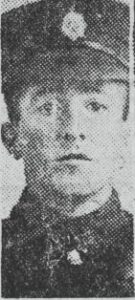
David Hughes, Private, 14762, South Wales Borderers. David was the son of John and Margaret Hughes, of Kidwelly. He married Mary Emily Musk at Seven Sisters in 1907, and the couple lived at 20, Bryndulais Row, Seven Sisters. David worked at the Yniscedwen Tinplate Works at Ystalyfera prior to the war, and enlisted at Ystradgynlais into the South Wales Borderers. He was posted to France on 11 December 1914, joining the 1st Battalion, South Wales Borderers, which was attached to 3 Brigade, 1st Division. It is not known when, but at some time later he transferred to the 2nd Battalion, South Wales Borderers. The battalion had begun their war in China, where they captured the German Garrison at Tientsin. The Battalion returned to England where they joined 87 Brigade, 29th Division. The Division moved to Gallipoli via Egypt, landing on 25 April 1915. They remained here until evacuation to Egypt on 11 January 1916, and then moved to the Western Front on 15 March 1916, taking up positions on the Somme, opposite Beaumont Hamel. David probably joined the battalion here, and was killed in action soon after, during the battalions first spell in the trenches. A relatively peaceful night was torn apart at 21.00 on 6 April 1916, when a box barrage fell to the rear of the trenches held by the battalion, and in the mayhem, their lines were attacked by a well-trained German raiding party. The 29th Division suffered a number of casualties during the raid, but embarrassment was caused by a large number of South Wales Borderers who were taken captive by the Germans. David was 30 years old when he was killed during the raid. He is buried in grave F. 6. in at Mesnil Ridge Cemetery, Mesnil Martinsart, France. Two of his brothers also fell, Sam and Willie Hughes, and are commemorated in their native Kidwelly.
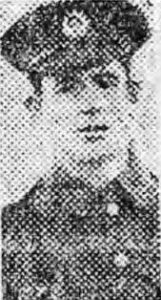
William Hull, Guardsman, 3492, Welsh Guards. William was the son of William and Anne Hull, of 7, Edwards Ville, Treharris. He lived and worked at Tynypant Farm, for his uncle, Gomer Davies, prior to the war, and enlisted into the Welsh Guards at Brecon. He was posted to France to join the 1st Battalion, Welsh Guards, which was attached to the 3rd Guards Brigade, Guards Division. The Welsh Guards had been formed by Royal Warrant on 26 February 1915, at White City, before landing at Le Havre on 18 August 1915, becoming attached to 3rd Guards Brigade, Guards Division. The Division saw its first major action during the Battle of Loos on 25 September 1915, remaining in the area during the coming months, where they also fought in the subsequent Action of Hohenzollern Redoubt. In July 1916 the Division moved to the Somme, where they fought at the Battle of Flers-Courcelette, and then at the Battle of Morval, capturing Lesboeufs Village. They moved to Flanders for the winter before taking up the line north of the 38th (Welsh) Division at Boesinghe, and from here took part in the Battle of Pilckem Ridge on 31 July 1917. The Guards Division was moved south to Cambrai later in the year in order to attempt to solidify the British line which had crumbled after early successes in the Battle of Cambrai had been reversed by a series of strong German counter-attacks, and moved to positions near Gouzeaucourt. William was badly wounded during the re-capture of the village and died that same day, on 1 December 1917. The 20-year-old was buried in grave VI. C. 4. in Rocquigny-Equancourt Road British Cemetery, Manancourt, France.
John James, Private, 93969, Royal Welsh Fusiliers. John was the son of John and Mary Ann James, of Caerlan, Abercrave. He had originally enlisted at Brecon into the South Wales Borderers, but upon being sent to France in 1918 was transferred to the 16th Battalion, Royal Welsh Fusiliers, which was attached to 113 Brigade, 38th (Welsh) Division. He probably joined the battalion on the Somme, where it held the line at Aveluy Wood, facing Thiepval Ridge. The division launched its assault across the flooded Ancre Valley on 21 August 1918, and assaulted Thiepval Ridge, before successfully capturing Pozieres and beginning its advance across the old Somme battlefields of 1916, as part of the great 100 days offensive. Over the coming weeks great swathes of land were recaptured from the Germans, and the Allies broke the Hindenburg Line at the end of September 1918, opening the doors to final victory. The 38th (Welsh) Division played an important part in this advance, and crossing through the Hindenburg Line began pursuing the enemy back towards the River Selle. John was killed in action while his battalion was advancing from Lempire towards La Terrière on 5 October 1918, the sole casualty of the battalion that day. The 21-year-old has no known grave and is commemorated on panel 6 of the Vis-en-Artois Memorial, Haucourt, France.
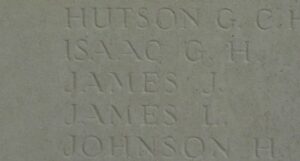
Daniel Jenkins, Trooper, 7/218, New Zealand Expeditionary Force. Daniel was born on 22 October 1880, the son of John and Margaret Jenkins, of Abercrave. His father was the Overman at the Abercrave Collieries before his death, while his elder brother William was under manager of the Ffaldau Colliery at Pontycymmer. Daniel had left Abercrave while young and served with the South African Mounted Police for three years prior to migrating to New Zealand. On 14 August 1914 he enlisted into the Canterbury Mounted Rifles, which was a regiment of the New Zealand Expeditionary Force and embarked from Wellington aboard HMNZT Tahiti for Egypt on 16 October 1914. The New Zealanders had sailed as part of the combined for with the Australians which was known as the ANZAC’s, and trained in Egypt in preparation for a move to the Western Front. Following the decision to force the passage of the Dardanelles Straits in order to attempt to capture Constantinople and force Turkey from the war, the ANZAC force was instead destined to land on the shores of Gallipoli on 25 April 1915, as part of a combined Anglo-French offensive. Heavy fighting raged during the day of the landings, but with the Turkish troops holding the high ground, no real gains were made. The position remained static like this for the coming months. Daniel was shot in the head while in trenches at Walkers Ridge on 17 July 1915 and was evacuated onto HM Hospital Ship Sicilia, where he died of his wounds on 24 July 1915, aged 34. He was buried at sea in the Mediterranean, and as a result is commemorated on panel 71 of the Lone Pine Memorial, Gallipoli. He was mentioned in despatches by Sir Ian Hamilton after his death, the award of which was published in the London Gazette of 5 November 1915. Daniel’s name does not appear in the original list of proposed names for the Abercrave War Memorial.
John Johnson, Shoeing Smith, 34506, Royal Field Artillery. John was born in Stourport, Worcestershire, the son of Isaac and Annie Johnson. He was an army reservist when he came to work at the Gwaunclawdd Colliery as a blacksmith some years prior to the war, lodging at Pantycwrt, Abercrave with Jane Joseph and her son Tom Rees Joseph. He was very well known locally, being one of the leading members of the local Boy Scouts troop. Upon the outbreak of war John re-joined the colours and embarked for France in August 1914 with the 119th Battery, Royal Field Artillery. He took part in the Battle of Mons on 23 August 1914 and was wounded during the overwhelming German attack on the British held city. John died of his wounds on the following day, 24 August 1914, aged 33. He has no known grave and is commemorated on the La Ferte-Sous-Jouarre Memorial, France.
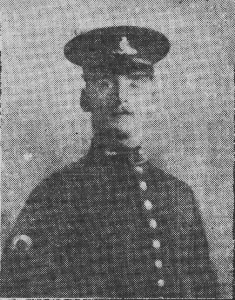
David Jones, Private, 12970, South Wales Borderers. David was the son of Hugh and Margaret Jones, of Tyncanol, Upper Chapel. He had lived with Daniel Williams of Pantycwrt and worked at the International Colliery at Abercrave for three years prior to enlisting at Brecon into the 4th Battalion, South Wales Borderers soon after the outbreak of war. The battalion was attached to 40 Brigade, 13th (Western) Division, and on 29 June 1915 sailed from Avonmouth for Mudros, preparatory for landing on Gallipoli on 15 July 1915, relieving the 29th Division. They left and returned to Mudros at the end of the month, and the entire Division landed at ANZAC Cove between 3 and 5 August 1915, taking part in the Battle of Sari Bair, and in further actions at Russell’s Top, and Hill 60, ANZAC. David was killed in action at ANZAC on 22 August 1915, aged 26. He is buried in grave I. C. 23. in Green Hill Cemetery, Gallipoli. His cousin, Morgan Jones, of the Welsh Regiment was also killed at Gallipoli. David’s name does not appear in the original list of proposed names for the Abercrave War Memorial.
William John Jones, MM, Sergeant, 139041, Royal Engineers. William was the only son of John and Mary Jones, of the Castle Hotel, Abercrave. He worked at the International Colliery prior to the war and enlisted at Brecon into the South Wales Borderers. Upon arriving in France, William, due to his mining experience, was transferred to the 256th Tunnelling Company, Royal Engineers. This was a common occurrence among former colliers, as their skills were needed to fight a secret underground war, digging tunnels and bunkers to hold troops, or mines beneath the enemy which would be filled with the explosive Ammonal, to be detonated during large scale assaults in order to create gaps in the line for troops to break through. The 256th Tunnelling Company became posted to the large force which was gathering on the Flanders coast in readiness for a planned offensive towards Zeebrugge in the summer of 1917. William became wounded here, and died of his wounds on 28 August 1917, aged 25. He is buried in grave II. L. 11. in Coxyde Military Cemetery, Belgium. William had been awarded the Military Medal earlier in the war.
John Frederick Kiernan, Corporal, 25843, Royal Field Artillery. John was the son of Jane Kiernan, of Bolton, Lancashire. He lived with his uncle, Thomas Charles Martin, in Sennybridge by 1911 and worked as a colliery brakeman at Abercrave. He enlisted at Caerphilly on 5 September 1914 into the Royal Field Artillery, and was posted to France on 20 July 1915, with B Battery, 90th Brigade, Royal Field Artillery. John was killed in action at Ypres on 10 June 1916, aged 24. He is buried in grave I. H. 1. in Vlamertinghe Military Cemetery, Belgium. His service papers show the award of a pension of 29/7 to his widow and three children, which is odd as no mention of a wife appears elsewhere in his papers, and his effects were sent to his mother, then Jane Waring, at Co-Operative Cottages, Low Leighton, Stockport. John’s name does not appear in the original list of proposed names for the Abercrave War Memorial.
Willie Lewis, Private, 200660, South Wales Borderers. Willie was the son of William and Jane Lewis, of Pontrhydarw, Abercrave. He enlisted at Brecon into the Brecknockshire Battalion, South Wales Borderers, and embarked with the battalion at Southampton for overseas service in Aden on 3 December 1914 after two months of coastal defence duty at Pembroke Dock. The Brecknocks were under the command of Lord Glanusk and had been sent to counter the threat of Turkish forces in the region. Aggressive Turkish patrols led to the Brecknocks being sent to support the Sultan of Lahej as part of the Aden Movable Column. The hot and arid conditions took a heavy toll on the young troops and a number succumbed to heat stroke on the march. Willie was among those to suffer such a tragic end, dying of heat apoplexy on 10 July 1915, aged 19. He has no known grave and is commemorated on the Heliopolis (Aden) Memorial, Egypt. His parents later lived in Penycae Inn, Penycae, Abercrave.
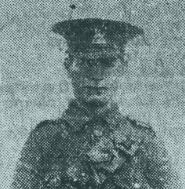
James Charles Mallows, Private, 26230, Welsh Regiment. James was the son of George and Alice Mallows, of Glan-y-Dwr, Ystradgynlais. He married Daisy Florence Badham, while working as a haulier in Bromley, on 7 February 1903 and the couple had moved to Rose Villa, Abercrave by 1911, with their three children. James enlisted at Brecon into the 17th Battalion, Welsh Regiment, which was a Bantam battalion attached to 119 Brigade, 40th (Bantam) Division. The Division moved to France during the first week of June 1916, and moved to the front near Loos. Late in 1916 it moved south to the Somme, and fought at the Battle of the Ancre, remaining in the area over the winter. In March 1917 the Germans withdrew to the Hindenburg Line, and the 40th Division followed the withdrawal. Later in the year it took part in the Battle of Cambrai, playing an important role in the attack on Bourlon Wood. James was later transferred to the 13th Battalion, Welsh Regiment (2nd Rhondda), which was attached to 114 Brigade, 38th (Welsh) Division and probably joined the division on the Somme, in the Aveluy Wood sector, in the spring of 1918. On 21 August 1918 elements of the division crossed the flooded Ancre valley before assaulting Thiepval Ridge, beginning the divisions part in the great 100 days offensive which followed. During the coming days the Germans were driven back across the old Somme battlefields of 1916 and by the end of August had reached the fortified village of Morval. On the morning of 1 September 1918, the 13th Welsh took part in the assault of 114 Brigade on trenches to the east of Morval and despite heavy machine-gun fire, completed the capture of their objectives by 06.00. James had been killed during the attack that morning. The 33-year-old has no known grave and is commemorated on panel 7 of the Vis-en-Artois Memorial, Haucourt, France. His brother, Albert Richard Mallows, also fell, and is commemorated at Ystradgynlais.
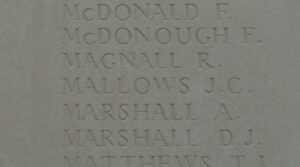
Andalusia Martin. Anadalusia was born in 1887 and was a Spaniard who lived at 2, Davies Street, Abercrave. Little else is presently known of him.
Hopkin Morgan, Driver, T/260798, Army Service Corps. Hopkin was the second son of William and Margaret Morgan, of Danygraig, Abercrave. He was a manager at a grocery shop at Caerlan prior to enlisting on 2 January 1917 into the Army Service Corps and was posted to the 2nd Cyclist Brigade at Cromer, on the Norfolk coast. He became ill during training in Norfolk, as a result of exposure during training and was hospitalised at Norwich before being discharged from the army as unfit on 25 July 1917 after being diagnosed as suffering from pericarditis. He returned home to Abercrave where he died on 16 January 1918, aged 24. He was buried in Ty Ny Coed Congregational Chapelyard, Abercrave. Hopkin is not commemorated by the Commonwealth War Graves Commission.
Thomas Morgan, MM, Sergeant, 14735, South Wales Borderers. Thomas was the son of David and Ann Morgan, of Victoria Street, Llandovery. He worked at the International Colliery and lodged with Mr and Mrs Jenkins at Clydfan, Station Road, Abercrave, and was a well-known hockey player prior to the war. Thomas enlisted at Brecon into the 1st Battalion, South Wales Borderers. The Battalion had landed at Havre on 13 August 1914, as part of 3 Brigade, 1st Division, and took part in the retreat from Mons to the Marne, before moving to Ypres, where they fought at First Ypres, and then at Aubers in early 1915. They took part in the Battle of Loos in September that year, and in 1916 fought on the Somme, from the Battle of Albert in July onwards, and were on the Ancre over the winter of 1916/17 and took part in the push to the Hindenburg Line in March 1917, before being posted to the Flanders Coast. They were rushed south to take part in Third Ypres. It was here, during the Second Battle of Passchendaele, that Thomas was wounded. He died of wounds on 10 November 1917 aged 28. He is remembered on the Tyne Cot Memorial, Belgium. Thomas was the holder of the Military Medal.
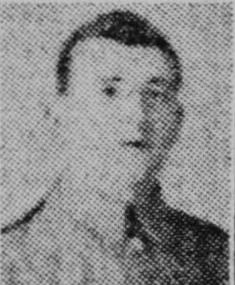
Thomas John Morgan, Gunner, 259754, Royal Field Artillery. Thomas was the son of John Morgan and Mary Ann Morgan (nee Hopkins), of Abercrave. He lived with his grandmother, Ann Hopkins, at Cefn Coed Uchaf, Abercrave prior to the war. Thomas enlisted at Brecon into the Royal Field Artillery and was posted to France to join the 21st Battery, Royal Field Artillery. Thomas was killed in action during the 100 days offensive, on 17 October 1918. The 21-year-old was buried in III. C. 4. in Busigny Communal Cemetery Extension, France
George Mountjoy, Private, 6482, Welsh Regiment. George was the son of William and Mary Ann Mountjoy, of Westleigh, Bideford, Devon. He was an army reservist, and after leaving the colours work brought him to west Wales, and he took up a gardening position in Blackpill, near Swansea, before moving to Abercrave, where he married Ethel Watts. George re-joined the 2nd Battalion, Welsh Regiment at Cardiff following the declaration of war. The battalion embarked for France attached to 3 Brigade, 1st Division, and landed on 14 August 1914 before entraining for Mons. The division took part in the epic retreat from Mons to the Marne, before taking part in a series of battles on the Marne and drove the Germans back over the River Aisne, where William Fuller of the 2nd Welsh won the first Welsh VC of the war. The division then moved to assist the defence of the Belgian city of Ypres, taking up positions along the Menin Road, where it saw heavy fighting in the First Battle of Ypres. George was taken prisoner at some time, probably here, and was held in a POW camp in Germany, where he died on 6 April 1915, aged 33. George is buried in Berlin South-Western Cemetery, Germany.
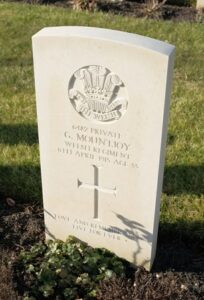
Arthur Palmer, Private, 18782, South Wales Borderers. Arthur was the husband of Ada Palmer, of 8, Gadds Green, Oakham, Dudley, Staffs. He worked as a coal hewer prior to the war and lodged at 7, Brookland Terrace Abercrave. He enlisted at Ystradgynlais into the 3rd Battalion, South Wales Borderers, and was posted to the 2nd Battalion, South Wales Borderers following their triumphant return from China in January 1915. The battalion entrained for Rugby to join 87 Brigade, 29th Division and sailed with the division from Avonmouth on 17 March 1915 for Egypt. On 25 April 1915 the division landed at Cape Helles, Gallipoli, and saw heavy fighting during the campaign before being evacuated to Egypt on 11 January 1916 and then moved to the Western Front on 15 March 1916. The division moved to the Somme sector, taking the line opposite Beaumont Hamel, and from here launched its assault against Y-Ravine on 1 July 1916, the opening day of the Somme offensive. At 06.20 the signal was sounded for the advance to begin. The Borderers leaped from their trenches and began the advance, but within some 200 yards German machine-guns had wiped out most of the attacking force. Arthur was 30 years old when he was killed during the advance on Y-Ravine that day. He is buried in grave D.37 in Y Ravine Cemetery, Beaumont-Hamel, France.
Edward Arnold Price, Private, 260107, Cheshire Regiment. Edward was born in Llandovery, the son of Arthur and Wilhelmina Price. The family later resided at 281, Tarreni Terrace, Godrergraig, Swansea. Edward enlisted at Aberdare into the 13th Battalion, Cheshire Regiment, which was part of 74 Brigade, 25th Division. The Division crossed to France during September 1915, and were moved into positions near Vimy Ridge, where they remained until June 1916. They then moved south to Warloy, and they took part in an assault near Thiepval on 3 July 1916, and remained on the Somme until moving to Ploegsteert in November 1916. They fought during Third Ypres, at the Battle of Messines and then moved to Pilckem to take part in the assault there. Edward was killed in Action during at Ypres, on 10 August 1917, aged just 19, and is remembered on the Ypres (Menin Gate) Memorial, Belgium. Edward’s name does not appear in the original list of proposed names for the Abercrave War Memorial.
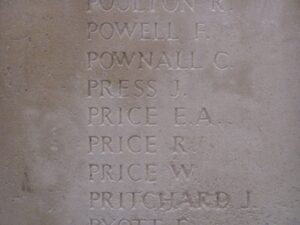
David John Samuels, Corporal, 290469, Welsh Regiment. David was the son of Thomas Samuels and Rachel Samuels (nee Davies), of Penybryn, Abercrave. He worked as a clerk at Abergavenny prior to the war and enlisted at Brecon into the 7th Battalion, Welsh Regiment. The 7th Welsh was a Cyclist battalion, and remained on home service for the duration of the war as part of the Tees Garrison. David was serving on the garrison when he was taken ill and found to be suffering from pneumonia. He was taken to hospital at Hartlepool where he died on 17 July 1918, aged 24. His body was brought home and David was buried in Carmel Calvinistic Methodist Chapelyard, Abercrave. For many years he remained forgotten by the Commonwealth War Graves Commission, until he was recently accepted for commemoration by them, and his name was added to the Brookwood (United Kingdom 1914-1918) Memorial, Hampshire.
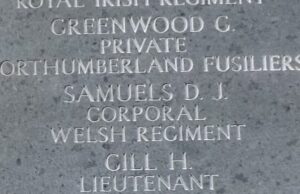
David Oswald Thomas, Private, 38555, Gloucestershire Regiment. David was the son of George and Margret Thomas, of Nantcae’refail, Penycae. He was a Theology student at Lampeter College prior to the war, but left there to enlist into the South Wales Borderers at Brecon and served in Ireland for a time. David was posted to France, probably early in 1918, and was transferred to the 12th Battalion, Gloucestershire Regiment, known as ‘Bristol’s Own’, and was attached to 95 Brigade, 5th Division. The division had been in Italy, but was hurriedly recalled to France following the German offensive of 21 March 1918, and moved to positions on the Franco-Belgian border. It played an important part in the Battle of Hazebrouck, especially in the Defence of Nieppe Forest, following the Germans secondary offensive, on the Lys, which was launched on 9 April 1918. On 5 June 1918 the battalion was in a rest area behind the lines when a German shell crashed in their area, killing six men and wounding several others. David, who was 19 years old when he was killed by the shell explosion, is buried in row B, grave 12, in Thiennes British Cemetery, France, alongside his comrades.
Thomas Thomas, Private, 12019, South Wales Borderers. Thomas was the son of Thomas and Elizabeth Thomas, of Sennybridge. He worked as a postman at Abercrave prior to the war. Thomas married Edith Jane Thomas in 1909 and the couple lived at Glaslyn, Abercrave, where their two children were born. Thomas enlisted at Swansea into the 1st Battalion, South Wales Borderers, and joined the battalion in France at some time in 1916. The battalion was attached to 3 Brigade, 1st Division and moved south to the Somme sector from Loos in July 1916 in order to take part in the Somme offensive. The division saw heavy fighting on the Somme, especially around the OG Lines and Munster Alley during the Battle of Pozieres. The division followed the German retreat to the Hindenburg Line in early 1917, and then moved to Coxyde, on the Flanders Coast, where forces had begun building up in the eventuality of an assault northwards towards Zeebrugge. This plan was called off as a result of the stalling of the Third Battle of Ypres, and at the end of October the division moved to support the offensive towards Passchendaele Ridge. On 8 November 1917 the 1st South Wales Borderers began moving to the front line from Poperinge, and took up positions at Valour Farm on 9 November, where it formed in readiness for a forthcoming assault. Detailed orders were issued to the battalion’s officers, detailing the disposition of troops and the objectives for each company, and also detailed a number of pill-boxes which needed to be over-run, a daunting task in this now marsh-like battlefield. On the morning of 10 November 1917, the Borderers went over the top and launched their attack, walking into their own barrage. Heavy fighting raged during the day, with the battalion being forced to beat off a series of German counter-attacks. Thomas was killed at some time during the action that day. The 32-year old was posted as missing, and it was 11 months later that he was adjudged to have been presumed killed. Thomas has no known grave and is commemorated on panel 66 of the Tyne Cot Memorial, Belgium.
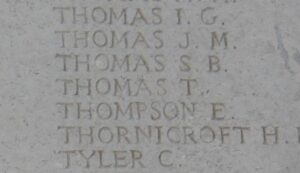
David Tyler, Private, 57046, Welsh Regiment. David was the only son of Frank Tyler and Olivia Tyler (nee Lewis), of Seagery House, Abercrave. He worked as a coalminer prior to enlisting into the Glamorgan Yeomanry at Bridgend on 21 October 1915. On 4 August 1916 David was posted to the Welsh Regiment Depot in France and a week later was posted to the 14th Battalion, Welsh Regiment (Swansea Pals), which was attached to 114 Brigade, 38th (Welsh) Division. The division had taken a mauling at Mametz Wood between 7 and 11 July 1916 and after a brief period at Hébuterne moved to positions north of Ypres, along the bank of the Yser Canal at Boesinghe. The division remained here for twelve months, taking part in the launching of the Third Battle of Ypres, when it assaulted the Pilckem Ridge on 31 July 1917, capturing all its objectives. 114 Brigade remained in the line for several days after the initial battle, and on 5 August 1917 the 14th Welsh moved forwards to take up the line west of the Steenbeek stream. David was killed in action during the day. The 21-year-old was originally buried on the battlefield, alongside other Welsh soldiers, but in 1920 their graves were exhumed and David was re-interred in grave XXV. D. 13. in New Irish Farm Cemetery, Belgium.
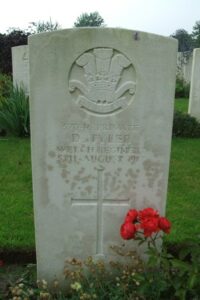
Oswald Watkins, Private, 26524, Welsh Regiment. Oswald was the son of Morgan and Ann Watkins, of Caerbont, Abercrave. He worked at the worked at the Gwaunclawdd Colliery prior to enlisting at Ystradgynlais into the Welsh Regiment and was posted to France on 15 April 1915, joining the 2nd Battalion, Welsh Regiment, which was attached to 3 Brigade, 1st Division. Oswald saw his first major action when the 1st Division took part in the Battle of Aubers Ridge, which saw the entire division, especially the 2nd Welsh, suffer heavy casualties. Its next major action was at the Battle of Loos, which was launched on 25 September 1915. On the opening day of the battle the 1st Division was in support of the 47th Division and the 15th (Scottish) Division, but failed to advance as the British gas cloud blew back over the advancing troops, causing chaos. The 1st Brigade managed to achieve some ground, but the 2nd Brigade became held up and were attacked in the flank by the Germans. The 2nd Welsh, with 3 Brigade, were ordered to move to the north to support 1 Brigade in its attack on Hulluch and the 2nd Welsh broke through the German lines at Lone Tree. The situation had by now become chaotic and the men spent a cold wet night on the battlefield, suffering intermittent shell and machine-gun fire. Heavy fighting continued the following morning, of 26 September 1915, and the 2nd Welsh came under very heavy fire. Oswald was killed on this, the second day of the battle. The 20-year-old has no known grave and is commemorated on panel 78 of the Loos Memorial, France.
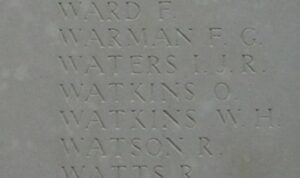
James George Whiting, MM, Lance Corporal, 7080, Wiltshire Regiment. James was the son of Frederick Henry Whiting, of Queen Street, Chedworth, Gloucester. He lived at Gamlas Cottage, Abercrave prior to enlisting at Devizes into the 1st Battalion, Wiltshire Regiment. The battalion landed at Rouen on 14 August 1914 attached to 7 Brigade, 3rd Division and took part in the Battle of Mons and the epic retreat south to the Marne. Following the battles of the Marne and the Aisne, which prevented the German break-through to Paris, the division moved to the Messines sector, seeing heavy fighting there before becoming involved in the famous Christmas Truce that year. At some time after James transferred to the 2nd Battalion, Wiltshire Regiment, either after having been wounded or being ill. The battalion was attached to 21 Brigade, 7th Division and had landed at Zeebrugge on 7 October 1914, taking part in fierce fighting during its withdrawal to Ypres. Both the 1st and 2nd Battalions of the Wiltshire Regiment saw heavy fighting during the war, but by the beginning of 1917 James was with the 2nd Battalion, which was by then attached to 21 Brigade, 30th Division. The division had followed the German withdrawal to the Hindenburg Line in March 1917 and in April too part in the First Battle of the Scarpe, in the Arras sector. James, who had by now been awarded the Military Medal, was killed in action here on 9 April 1917. The 30-year-old is buried in grave VI. E. 24. In Wancourt British Cemetery, France.
Dewi Williams, Private, 19342, South Lancashire Regiment. Dewi was the son of David and Mary Anne Williams, of Llanfryn, Colbren. He worked as a collier prior to enlisting at Neath on 18 May 1915 into the 3rd Battalion, South Lancashire Regiment. On 1 October 1915 Dewi was drafted to France, joining the 2nd Battalion, South Lancashire Regiment, which had recently become attached to 75 Brigade, 25th Division. The Division had landed in France on 26 September 1915, and was posted to the Vimy area, where it defended Vimy Ridge against a German attack in May 1916. It then moved to the Warloy area and attacked on 3 July near Thiepval. The 25th Division fought throughout the Battle of the Somme, and took part in the capture of Stuff Redoubt on 9 October. On 21 October 1916 the division, supported by tanks and fighting alongside the 28th Division, captured Regina Trench and Redoubt. Dewi was 21 years old when he was killed in action at Regina Trench on 21 October 1916, and was buried on the battlefield by his comrades. His grave was discovered after the war and his remains were re-interred in grave I. J. 24. in Serre Road Cemetery No.1, France. Dewi’s name does not appear in the original list of proposed names for the Abercrave War Memorial.
Joseph William Thomas Williams, Private, 34392, Cheshire Regiment. Joseph was the son of Daniel and Sarah Williams, of Brynderi, Abercrave. He worked as a collier prior to enlisting at Newport, Monmouth on 24 March 1916 into the 3rd Battalion, South Wales Borderers. On 30 March 1917 he was transferred to a Labour Battalion of the King’s Liverpool Regiment, and three weeks later was transferred to the 3rd Battalion, Cheshire Regiment. On 6 December 1917 Joseph deserted, and did not re-join his unit until 11 February 1918. He was found guilty of desertion by FGCM and sentenced to three months detention for losing his equipment, but the sentence was rescinded after Joseph volunteered to go to France, and on 26 March 1918 he joined the 9th Battalion, Cheshire Regiment, which was attached to 56 Brigade, 19th (Western) Division. He joined the battalion while it was in the midst of a fighting retreat past Bapaume, following the German offensive of 21 March 1918, and was with the battalion when the division was moved north, to positions near Messines, in the Lys sector, to rebuild. The Germans launched a secondary offensive here on 10 April 1918, and Joseph was wounded by shrapnel in the legs. He spent three months in various hospitals before going AWOL again in July 1918, but gave himself up and was confined to barracks for a week before re-joining his battalion in France on 31 July 1918 in time to take part in the 100 days offensive which would ultimately win the war. Joseph was killed in action during the Battle of the Sambre, on 5 November 1918, aged 35. He is buried in grave IV. H. 6. in Wellington Cemetery, Rieux-En-Cambresis, France. Joseph’s name does not appear in the original list of proposed names for the Abercrave War Memorial.
Rosser Williams, Private, 20766, South Wales Borderers. Rosser was born at Tanyrallt, Abercrave. He worked as a haulier at Newport prior to the war and married Florence McCarthy in 1915. Rosser resided with his wife and two children at 31, Goodrich Crescent, Newport prior to enlisting in the town into the 10th Battalion, South Wales Borderers. The battalion trained at Colwyn Bay as part of the newly formed Welsh Army Corps and moved to Winchester with 115 Brigade, 38th (Welsh) Division in the summer of 1915. The division crossed to France in December 1915 and spent the winter in the nursery sector of Fleurbaix. The division saw its first major action during its famous attack on Mametz Wood in July 1916, before moving to Hébuterne and then to the Boesinghe sector north of Ypres. The division held this sector, along the Yser canal bank, for almost a year before launching its assault on the Pilckem Ridge on 31 July 1917, on the opening day of the Third Battle of Ypres. The 10th South Wales Borderers attacked from Kiel Cottage against the slopes of Iron Cross ridge, and Rosser was killed in action at some time during the assault. The 31-year-old has no known grave and is commemorated on panel 22 of the Ypres (Menin Gate) Memorial, Belgium. Rosser’s name does not appear in the original list of proposed names for the Abercrave War Memorial.
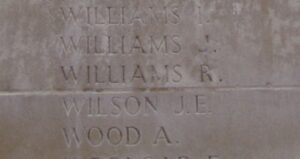
World War Two, 1939-1945
Thomas Islwyn Elias, Aircraftman 1st Class, 1286282, Royal Air Force Volunteer Reserve. Thomas was the son of Mr. and Mrs. Gwilym Elias, of Ael-y-Bryn, Station Road, Abercrave. He worked in London prior to the war and lived in Croydon. Thomas married Megan Howells in London in 1937 and the couple resided in 43, Aynoe Road, West Kensington. He enlisted into the Royal Air Force Volunteer Reserve and trained as an Aircraftman 1st Class before being posted to Singapore at some time prior to the Japanese invasion of the Malayan Peninsula. The invasion took place from Indochina, their troops moving into northern Malaya and Thailand by amphibious assault on 8 December 1941. The attack took place almost at the same time the Japanese attacked Pearl Harbour and brought the USA into the war. On 8 February 1942 the Japanese began their attacks on the British held garrison of Singapore. By the time the Singapore Garrison was surrendered on 15 February 1942, over 5,000 Allied troops had been killed or wounded. Over 85, 000 Allied prisoners were marched into captivity. Thomas died in captivity on 29 November 1943, aged 27, during the sinking of the Japanese ‘Hell Ship’ Suez Maru, when it was torpedoed by the US submarine USS Bonefish. Suez Maru contained 548 British and Dutch POW’s, and only one man survived. Most were drowned when the ship sunk, while the survivors were machine-gunned on the water by a Japanese mine-sweeper. Thomas has no known grave and is commemorated on column 428 of the Singapore Memorial, Singapore.
Alwen May Evans, Corporal, 2076144, Women’s Auxiliary Air Force. Alwen was the daughter of Edwin Cadwalader Evans and Gwendoline Maud Evans (nee Watkins) of Abercrave. She enlisted into the Women’s Auxiliary Air Force. Little is known of her but she died at Morriston Hospital on 24 February 1945, aged 21. Alwen is buried in St. David’s Churchyard, Abercrave, south-east of the Church in grave 492.
Vivian Russell Hart, Ordinary Seaman, D/JX 168364, Royal Navy. Vivian was born on 3 January 1919, the son of Mr. and Mrs. Alfred Hart of Pantycelyn, Abercrave. He enlisted into the Royal Navy and was posted aboard the D-class destroyer HMS Decoy. Following outbreak of war, Decoy was assigned to the Mediterranean Fleet, but was forced to carry out extensive repairs in December 1940, before being transferred to Freetown, for escort duties. She returned to the Mediterranean six months later and took part in several successful operations against Italian shipping. She was in Alexandria on 13 November 1940 when she was struck by a bomb, which penetrated the ship. Vivian was wounded by the bomb strike and died aboard HM Hospital Ship Maine on 13 November 1940, aged 20. His body was brought ashore, and he was buried in grave N. 59 in Alexandria (Chatby) Military and War Memorial Cemetery, in Egypt.
David Glyndwr Lewis, Ordinary Seaman, C/SR 16633, Royal Navy. David was the son of Henry Lewis and Ceinwen Lewis (nee Jones) of Abercrave. He enlisted into the Royal Navy and was posted aboard the converted passenger liner HMS Forfar. She had been requisitioned by the Royal Navy in 1939 and converted into an armed merchant cruiser. On 2 December 1940 Forfar, operating on the Northern Patrol, was en route to join Convoy OB251, when she was torpedoed and sunk by the German submarine U-99, about 500 miles west of Ireland. Over 170 men were drowned in the sinking, including David, who was 22 years old. David is commemorated on panel 36, column 2 of the Chatham Naval Memorial, Kent.
Jenkin Gildas Lewis, Sergeant, 1283419, Royal Air Force Volunteer Reserve. Jenkin was the only son of Sidney John Lewis and Susanna Mary Lewis (nee Williams) of Abercrave. He enlisted into the Royal Air Force Volunteer Reserve and after training as a flight engineer was posted to 12 Squadron, Royal Air Force, which was equipped with the Vickers Wellington, based at RAF Binbrook in Lincolnshire. The squadron converted to the Avro Lancaster in 1942. During the early hours of 18 June 1943, Jenkin was taking part in a training flight aboard Lancaster I, Serial W4374, when the aircraft suffered an inner engine failure. Its pilot, Sergeant John Broomfield Lindup, began heading to base, but suffered the failure of a second engine. Upon the Lancaster’s arrival at Binbrook the crew had difficulty making contact with ground control and, as a result, the runway flares were not lit and the Lancaster came down in a nearby wood and burst into flames. Jenkin, his pilot, Sergeant Lindup, and their Navigator, Sergeant Eugene Salmers, were all killed in the crash. Jenkin, who was 22-years-old, was brought home for burial in St. David’s Churchyard, Abercrave, south of the Church, in grave 670.
John Price Morgan, Sergeant, 626428, Royal Air Force Volunteer Reserve. John was the son of Richard and Esther Morgan of Abercrave, Swansea. He enlisted into the Royal Air Force Volunteer Reserve and after training was posted to 500 Squadron, Royal Air Force, which was equipped with the Avro Anson I, and was attached to RAF Coastal Command. At 14.00 on 28 June 1940 John took off from RAF Detling aboard Andon N5226, which had been despatched to Boulds on convoy escort duties. The aircraft failed to return after its flight, and was presumed to have come down in the North Sea. John was 29 years old when he was killed that day, and is commemorated on panel 17 of the Runnymede Memorial, Surrey.
Ilbert Parsons, Boy 1st Class, D/JX 162778, Royal Navy. Ilbert was the son of Morgan Parsons and Lilian Parsons (nee Smith) of Abercrave. He enlisted into the Royal Navy and was posted aboard the light cruiser, HMS Gloucester. In August 1939, Gloucester was assigned to the China Station, but was then transferred to the Indian Ocean and later to South Africa. She was transferred to the Mediterranean Fleet for convoy duties in 1940. On 22 May 1941 Gloucester was attached to Force C, which was attempting to prevent the Germans from re-enforcing Crete following the German paratrooper invasion of the island, when she was attacked by German dive-bombers, and sank with the loss of 722 lives. Ilbert was among the dead. He was 17 years old and is commemorated on panel 49, column 3 of the Plymouth Naval Memorial, Devon.
Clifford Vernon Walters, Flying Officer, 45188, Royal Air Force. Clifford was the son of David Rees Walters and Gwenllian Walters (nee Lewis), of Plasydarren, Penycae, and the husband of Edwina Walters. He served as a pilot officer with the Royal Air Force. He had served with the RAF since about 1921, and had seen active service in India before returning to Britain. He died on active service near Blackpool on 23 March 1941, aged 27, and is buried in grave 668 in St. David’s Churchyard, Abercrave. His brother, Glyndwr Lewis Walters, also fell.
Glyndwr Lewis Walters, Sergeant, 533619, Royal Air Force. Glyndwr was the son of David Rees Walters and Gwenllian Walters (nee Lewis), of Plasydarren, Penycae. He served with 210 Squadron, RAF, which was equipped with the Short Sunderland flying boat and flew with RAF Coastal Command, based at Pembroke Dock. On 29 June 1940, Glyndwr took off from Pembroke Dock aboard Sunderland N9026, which had been ordered to carry out convoy escort duties from Milford Haven, but went missing, presumed having crashed off the south coast of Ireland, with the loss of all her crew of nine. Wreckage from the Sunderland was later recovered by a Milford based trawler. Glyndwr was 26-years-old when he died that day and is commemorated on panel 20 of the Runnymede Memorial, Surrey. His brother Clifford Vernon Walters also fell.
Malcolm Owen Watkins, Private, 14605884, Monmouthshire Regiment. Malcolm was the son of Mr. and Mrs. William Garfield Watkins, of Gorffwysfan, Abercrave. He served with the 2nd Battalion, Monmouthshire Regiment, which was attached to the 53rd (Welsh) Division. The division had spent much of the war on home service, first in Northern Ireland, then in the south of England, before landing in Normandy in mid-June 1944. The division moved into positions near the River Odon towards the end of the month and took part in a series of bloody engagements during the attempt to break out of the Normandy beach-head. Malcolm was killed during the infamous fighting in the Bocage, on 14 August 1944. The 19-year-old is buried in grave II. A. 4. in Brouay War Cemetery, France.